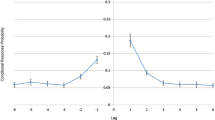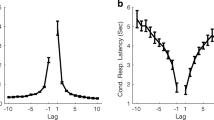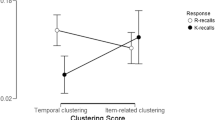Abstract
One widely accepted empirical regularity in free recall holds that when people successively transition from report of one list item to another, they prefer transitions across short lags (e.g., by reporting items from adjacent serial positions) to transitions involving large lags. This regularity has provided crucial support for the temporal context model (TCM), a model of the evolution of temporal context in episodic memory (Howard & Kahana, 2002a). We report a reanalysis of 14 data sets that shows that, contrary to the presumed preference for short lags, people often produce transitions with larger lags during recall. We show that these data cannot be accommodated by the TCM. We furthermore show that existing applications of the model have, for mathematical convenience, introduced assumptions that have circumvented its core principle of context evolution. When we instantiated the TCM as it was actually described, with a gradually evolving context, we found that its behavior qualitatively departed from that of the version currently implemented, but that the model was still unable to capture the nature of transitions in free recall. We conclude that the TCM requires further modification and development before it can explain the data that constitute its main source of support. Supplementary materials relevant to this article can be downloaded from the Psychonomic Society’s Norms, Stimuli, and Data Archive, www.psychonomic .org/archive.
Similar content being viewed by others
References
Akaike, H. (1974). A new look at the statistical model identification. IEEE Transactions on Automatic Control, 19, 716–723.
Brown, G. D. A., Neath, I., & Chater, N. (2007). A temporal ratio model of memory. Psychological Review, 114, 539–576.
Brown, G. D. A., Preece, T., & Hulme, C. (2000). Oscillator-based memory for serial order. Psychological Review, 107, 127–181.
Burnham, K. P., & Anderson, D. R. (2002). Model selection and multimodel inference: A practical information-theoretic approach (2nd ed.). New York: Springer.
Davelaar, E. J., Goshen-Gottstein, Y., Ashkenazi, A., Haarmann, H. J., & Usher, M. (2005). The demise of short-term memory revisited: Empirical and computational investigations of recency effects. Psychological Review, 112, 3–42.
Dennis, S., & Humphreys, M. S. (2001). A context noise model of episodic word recognition. Psychological Review, 108, 452–478.
Estes, W. K. (1955). Statistical theory of spontaneous recovery and regression. Psychological Review, 62, 145–154.
Farrell, S. (2006). Mixed-list phonological similarity effects in delayed serial recall. Journal of Memory & Language, 55, 587–600.
Glanzer, M., & Cunitz, A. R. (1966). Two storage mechanisms in free recall. Journal of Verbal Learning & Verbal Behavior, 5, 351–360.
Glenberg, A. M., Bradley, M. M., Stevenson, J. A., Kraus, T. A., Tkachuk, M. J., Gretz, A. L., et al. (1980). A two-process account of long-term position effects. Journal of Experimental Psychology: Human Learning & Memory, 6, 355–369.
Glenberg, A. M., & Swanson, N. G. (1986). A temporal distinctiveness theory of recency and modality effects. Journal of Experimental Psychology: Learning, Memory, & Cognition, 12, 3–15.
Howard, M. W. (2004). Scaling behavior in the temporal context model. Journal of Mathematical Psychology, 48, 230–238.
Howard, M. W., Fotedar, M. S., Datey, A. V., & Hasselmo, M. E. (2005). The temporal context model in spatial navigation and relational learning: Toward a common explanation of medial temporal lobe function across domains. Psychological Review, 112, 75–116.
Howard, M. W., & Kahana, M. J. (1999). Contextual variability and serial position effects in free recall. Journal of Experimental Psychology: Learning, Memory, & Cognition, 25, 923–941.
Howard, M. W., & Kahana, M. J. (2002a). A distributed representation of temporal context. Journal of Mathematical Psychology, 46, 269–299.
Howard, M. W., & Kahana, M. J. (2002b). When does semantic similarity help episodic retrieval? Journal of Memory & Language, 46, 85–98.
Howard, M. W., Kahana, M. J., & Wingfield, A. (2006). Aging and contextual binding: Modeling recency and lag recency effects with the temporal context model. Psychonomic Bulletin & Review, 13, 439–445.
Howard, M. W., Venkatadass, V., Norman, K. A., & Kahana, M. J. (2007). Associative processes in immediate recency. Memory & Cognition, 35, 1700–1711.
Howard, M. W., Youker, T. E., & Venkatadass, V. S. (2008). The persistence of memory: Contiguity effects across hundreds of seconds. Psychonomic Bulletin & Review, 15, 58–63.
Kahana, M. J. (1996). Associate retrieval processes in free recall. Memory & Cognition, 24, 103–109.
Kahana, M. J., & Howard, M. W. (2005). Spacing and lag effects in free recall of pure lists. Psychonomic Bulletin & Review, 12, 159–164.
Kahana, M. J., Howard, M. W., Zaromb, F., & Wingfield, A. (2002). Age dissociates recency and lag recency effects in free recall. Journal of Experimental Psychology: Learning, Memory, & Cognition, 28, 530–540.
Klein, K. A., Addis, K. M., & Kahana, M. J. (2005). A comparative analysis of serial and free recall. Memory & Cognition, 33, 833–839.
Laming, D. (1999). Testing the idea of distinct storage mechanisms in memory. International Journal of Psychology, 34, 419–426.
Lewandowsky, S., & Farrell, S. (2008a). Phonological similarity in serial recall: Constraints on theories of memory. Journal of Memory & Language, 58, 429–448.
Lewandowsky, S., & Farrell, S. (2008b). Short-term memory: New data and a model. In B. H. Ross (Ed.), The psychology of learning and motivation (Vol. 49, pp. 1–48). San Diego: Academic Press.
Murdock, B. B. (1962). Direction of recall in short-term memory. Journal of Verbal Learning & Verbal Behavior, 1, 119–124.
Murdock, B. B. (1974). Human memory: Theory and data. Potomac, MD: Erlbaum.
Murdock, B. B. (1997). Context and mediators in a theory of distributed associative memory (TODAM2). Psychological Review, 104, 839–862.
Murdock, B. B., & Okada, R. (1970). Interresponse times in singletrial free recall. Journal of Experimental Psychology, 86, 263–267.
Neath, I. (1993). Contextual and distinctive processes and the serial position function. Journal of Memory & Language, 32, 820–840.
Nelder, J. A., & Mead, R. (1965). A simplex method for function minimization. Computer Journal, 7, 308–313.
Postman, L., & Phillips, L. W. (1965). Short-term temporal changes in free recall. Quarterly Journal of Experimental Psychology, 17, 132–138.
Raaijmakers, J. G. W., & Shiffrin, R. M. (1981). Search of associative memory. Psychological Review, 88, 93–134.
Sirotin, Y. B., Kimball, D. R., & Kahana, M. J. (2005). Going beyond a single list: Modeling the effects of prior experience on episodic free recall. Psychonomic Bulletin & Review, 12, 787–805.
Tan, L., & Ward, G. (2000). A recency-based account of the primacy effect in free recall. Journal of Experimental Psychology: Learning, Memory, & Cognition, 26, 1589–1625.
Wagenmakers, E.-J., & Farrell, S. (2004). AIC model selection using Akaike weights. Psychonomic Bulletin & Review, 11, 192–196.
Zaromb, F. M., Howard, M. W., Dolan, E. D., Sirotin, Y. B., Tully, M., Wingfield, A., et al. (2006). Temporal associations and prior-list intrusions in free recall. Journal of Experimental Psychology: Learning, Memory, & Cognition, 32, 792–804.
Author information
Authors and Affiliations
Corresponding author
Additional information
Collaboration on this project was assisted by an Australian Research Council international linkage grant to S.L., Gordon Brown, and S.F. The second author was supported by an Australian professorial fellowship from the Australian Research Council.
Electronic supplementary material
Rights and permissions
About this article
Cite this article
Farrell, S., Lewandowsky, S. Empirical and theoretical limits on lag recency in free recall. Psychonomic Bulletin & Review 15, 1236–1250 (2008). https://doi.org/10.3758/PBR.15.6.1236
Received:
Accepted:
Published:
Issue Date:
DOI: https://doi.org/10.3758/PBR.15.6.1236




